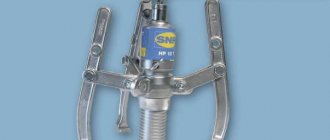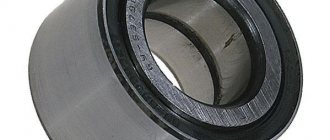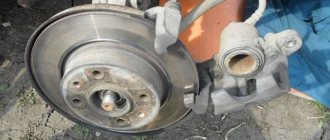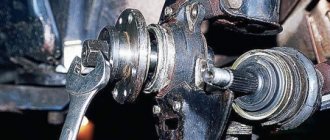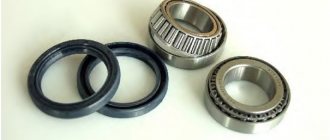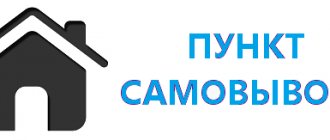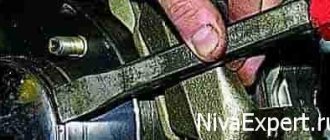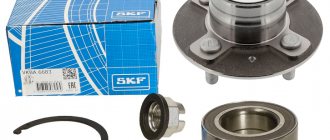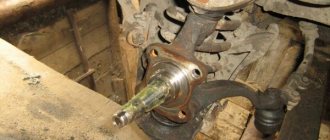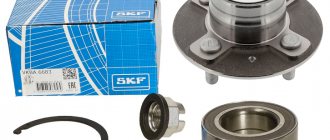Suspension elements are the most vulnerable parts of a car, which during operation are constantly exposed to mechanical damage and external factors. Among all suspension components, hub bearings are considered the most significant, because they are responsible for rotating the wheel and absorbing the load that occurs when the car is moving. It is important to keep them in perfect condition, and at the first sign of trouble, the wheel bearings need to be replaced.
Timely and, most importantly, high-quality replacement will allow you to avoid emergency situations, as well as extend the life of other suspension elements. The first signs indicating wear of parts include wheel play and noise in the suspension. How to identify a malfunction and how to replace the wheel bearings - all this will be discussed in this article.
The main signs of wheel bearing failure
There are the following signs by which you can recognize that there is a malfunction in the wheel bearing:
- The occurrence of wheel play, no matter what - lateral or along the axle. This problem can be accompanied either by uneven wear of the tire tread, or when driving straight, the car constantly moves to the side, or the steering wheel begins to beat, as is the case with insufficiently correct wheel balancing;
- The presence of a hum (noise) in the hub area that changes its tone depending on the speed at which the car is moving. Due to inexperience, drivers may attribute such sounds to violations in wheel alignment adjustments or attribute them to a special reaction of the tire treads.
How to choose a wide wheel bearing for a VAZ 2110
Inner diameter (d): 34mm; External diameter (D): 64 mm; Width (H): 37 mm.
- VAZ 2110 front bearing number: 6-256907 (designation)
- When purchasing a front wheel bearing for a VAZ 2110, there are three options:
- JSC Saratov Bearing Plant - experts say that the company produces the best wheel bearings. The plant's products are marked with the additional marking "SZZ".
The Samara Bearing Plant produces inexpensive products that are not of good quality. They are good if you want to save money. Parts will need to be replaced after 20,000 km. The price of a VAZ 2110 wheel bearing from this brand is half the price: 150-320 rubles.
Correct wheel bearing diagnosis
The sequence of actions must correspond to the following algorithm:
- The wheel to be diagnosed is removed so that it can rotate freely. In this case, the car is either placed on a lift, or a working jack is used;
- You have to spin the wheel to make it clear. That its rotation is free. There are cases where noise occurs, the cause of which is insufficient brake release of the wheel, while well pads rub against the drum or disk;
- You need to rock the wheel, taking it by both edges, upper and lower, both towards you and away from you. After which the procedure is resumed after a ninety-degree turn is made.
When play is detected, a check is made to see how the hub nuts are tightened. This is where a large-levered crank comes in handy. In addition to being designed to withstand high forces, the size of its socket head is considered to be the most suitable.
You will also need a technical specification for automotive equipment indicating the tightening torque for the bearing nut.
Actions are carried out in the following sequence:
- The nut cap is removable for protection;
- If there is a cotter pin, it must be removed;
- While driving, an assistant must press the brake device to secure the wheel;
Using a prepared wrench, the tightening torque force is checked. If the bearing meets specifications but there is still play, the bearing must be replaced.
Disassembly
Required : engage first gear and place shoes under the wheels. Prepare a narrow chisel, a 30mm socket, pliers, a needle file and a standard set of tools. The wheel bearing can be replaced on a level surface, but it is more convenient to do so on an inspection ditch or a lift.
Procedure:
- Remove the hub cap.
- Straighten the dented shoulder of the wheel bearing nut in two places using a narrow chisel.
- Loosen the hub bearing nut using a 30mm socket. The head and driver must be strong enough to transmit the required force.
| If while driving you notice that there is something humming in the front suspension, then most likely the problem is in the front wheel hub, in the bearing. You can replace the front wheel bearing yourself, but this will require some experience. |
Loosen the wheel mounting bolts, and then hang both front wheels, otherwise the anti-roll bar will interfere with dismantling, pushing the suspension elements up. Remove the wheel, the brake pad guide together with the caliper and the brake disc (tie them so that they do not hang on the brake hose).
Replacing the hub bearing on the front axle
The general algorithm is the same, with the exception of features in the design of the car:
- The battery device is switched off;
- The bolts on the wheel are loosened;
- Using a lift or shoes with a jack, the front wheel is raised;
- The protective cap at the hub nut is compressed. Then the hose is removed from the drive shaft, more specifically from the threaded cap;
- After the assistant presses the brake, the nut on the hub is unscrewed;
- The wheel is removed;
- The brake caliper is unscrewed from its mounting location so as not to damage the hoses. The part is carefully secured to the body with wire. The hoses must remain free;
- The ABS sensor connector is disconnected;
- The disk is removed after unscrewing the screws;
- The steering tip is disconnected from the rack, then the same is done with the conical tip;
- The stand must be pulled slightly towards you to remove the splined part from the hub;
- Using a puller, you have to remove the hub and the bearing with it;
- The new set is pressed in. A separately made bearing is installed not in the old hub, but in the new one;
Assembly is carried out in reverse order.
Replacing the wheel bearing on the rear wheels
The operations are performed in the same way and in the same order as in the case of the front wheels.
The process differs as follows:
- There is no need to disconnect the tie rod;
- There is also no need to dismantle the CV joint;
- In the case of using a press with a lever suspension on the machine, the rack will not be dismantled, but the lever device with the hub will be carried out.
So the procedure in practice turns out to be simpler to perform.
Varieties of nodal structures
The joint structure connects the shaft, steering knuckle and wheel. A single housing of the unit is formed by pressing technology, which is used to securely fix the bearing in the hub. It is also used for securing in the cam mechanism. An alternative option is a flange connection.
The rotation path and placement of components led to the classification into the following types:
- Double row ball (roller) bearings. They belong to the first generation of HUB I. Structurally, they are represented by an outer casing that combines 2 blocks of balls or rollers, and an internal one, divided into 2 zones. For sealing to prevent the ingress of water, dust and other contaminants, the device includes a separator with O-rings.
- Hub units made of 2 single row bearings. They are equipped with the front axles of cars with rear-wheel drive and low torque (old versions of Fiat, UAZ Patriot, VAZ models). Maintenance structures must be periodically adjusted and lubricated.
- Bearings combined with the hub. Represent the 2nd and 3rd generations of HUB II, III. In the hub body, outer and inner races are fixed through flanges. One side is connected to the knuckle, the brake disc is fixed to the other and the wheel screws are tightened. The maintenance-free design is installed on the drive and driven wheels.
In units of the 3rd type, bearings rotate along the inner and outer rings. Additionally, speed sensors and ABS are built into the mechanism.

